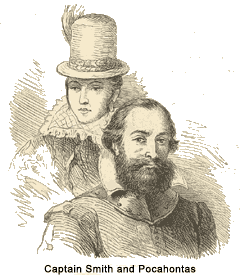John Smith was born in Willoughby, England, and was apprenticed to a merchant at a young age. His father’s death in 1596, prompted him to change his life drastically to travel and adventure.
Smith fought in the wars for Dutch independence from Spain and later with the Austrians against the Turks in Hungary. He was wounded and captured in Transylvania, and forced into slavery by the Turks. Smith murdered his captor, escaped into Russia, and managed eventually to wend his way back to England. Smith’s written account of these adventures has been dismissed by some authorities as fanciful self-promotion, but others have noted corroborative details in the narrative that lend authenticity to his story.
In 1604, John Smith sought an investment in a New World commercial venture and joined the London Company. In December 1606, he sailed with Captain Christopher Newport for North America, arriving in Chesapeake Bay in April of the following year. After exploring the area for several weeks, the Jamestown colony was established in a low-lying area on the James River, in May 1607.
 John Smith took responsibility for exploring the surrounding environs, traveling up several of the region’s many rivers. He prepared a remarkably accurate map, based on his excursions. Smith also became the chief contact with the neighboring Indians, Algonkian-speaking members of the Powhatan Confederacy.
In December 1607, John Smith was abducted by tribal members. According to one of Smith’s accounts, he was rescued from execution by the pleas of the chief’s daughter, Pocahontas. Later authorities have speculated that Smith simply misinterpreted an Indian adoption ritual.
John Smith managed to return to Jamestown after a month in captivity, but his self-assurance and prickly personality offended other colonists. His opponents conspired against him and succeeded in having him imprisoned and sentenced to death. Only the timely reappearance of Christopher Newport, arriving with a boatload of new settlers, saved Smith’s life.
With Newport’s backing, John Smith assumed a leadership role at Jamestown. He supervised the enlargement of the town’s fortifications, the training of a militia and crop planting.
In 1609, Smith was badly injured when his gunpowder pouch exploded, forcing his return to England for medical attention. The years 1609 and 1610 were the colony's low point, the so-called “starving time” during which Smith’s leadership was badly missed.
John Smith was not able to arrange a return to Jamestown, but in 1614, other English commercial interests sent him back to North America. He explored the coasts of present-day Maine and Massachusetts, ranging from Penobscot Bay to Cape Cod. Smith dubbed the area “New England” then returned home with a valuable cargo of pelts and fish.
In 1615, Smith set off on another venture to the New World, but was captured by pirates. He managed to escape after several months in captivity.
A final effort to reach the New World in 1617 was a failure; his outfitted ships were prevented from sailing for months because of adverse winds. The plan was scrapped and Smith devoted his remaining years to writing. His works include The General Historie of Virginia, New England and the Summer Isles (1624), A Description of New England (1625), the True Travels, Adventures and Observations of Captaine John Smith (1630).
John Smith took responsibility for exploring the surrounding environs, traveling up several of the region’s many rivers. He prepared a remarkably accurate map, based on his excursions. Smith also became the chief contact with the neighboring Indians, Algonkian-speaking members of the Powhatan Confederacy.
In December 1607, John Smith was abducted by tribal members. According to one of Smith’s accounts, he was rescued from execution by the pleas of the chief’s daughter, Pocahontas. Later authorities have speculated that Smith simply misinterpreted an Indian adoption ritual.
John Smith managed to return to Jamestown after a month in captivity, but his self-assurance and prickly personality offended other colonists. His opponents conspired against him and succeeded in having him imprisoned and sentenced to death. Only the timely reappearance of Christopher Newport, arriving with a boatload of new settlers, saved Smith’s life.
With Newport’s backing, John Smith assumed a leadership role at Jamestown. He supervised the enlargement of the town’s fortifications, the training of a militia and crop planting.
In 1609, Smith was badly injured when his gunpowder pouch exploded, forcing his return to England for medical attention. The years 1609 and 1610 were the colony's low point, the so-called “starving time” during which Smith’s leadership was badly missed.
John Smith was not able to arrange a return to Jamestown, but in 1614, other English commercial interests sent him back to North America. He explored the coasts of present-day Maine and Massachusetts, ranging from Penobscot Bay to Cape Cod. Smith dubbed the area “New England” then returned home with a valuable cargo of pelts and fish.
In 1615, Smith set off on another venture to the New World, but was captured by pirates. He managed to escape after several months in captivity.
A final effort to reach the New World in 1617 was a failure; his outfitted ships were prevented from sailing for months because of adverse winds. The plan was scrapped and Smith devoted his remaining years to writing. His works include The General Historie of Virginia, New England and the Summer Isles (1624), A Description of New England (1625), the True Travels, Adventures and Observations of Captaine John Smith (1630).